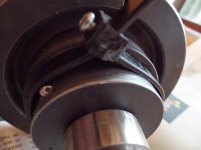This one is more challenging than usual. The length of spring stick-out, the use of three balls instead of one, and the rather limited space "inboard" of the balls to slide a temporary ring out of the way as the dial goes on hamper the usual assembly tricks.
If I were stuck with it, I would take a piece of cheap plate thin enough to slide out of the way, and make a wide flange in the style of a narrow two-piece clamping collar out of it. I would mount a screw-fastened tab for each of the ball positions, so that I could compress manually the ball+spring for each position independently then rotate the tab to hold the ball in position and fasten the screw. Once I got all three balls in position, I'd slide up the dial and push the flange out of the way, then disassemble the flange.
If I had a bunch of these to do, I would mill cam recesses into the flange face instead of using tabs. The max diameter of the cam recess would just hold a ball+spring snugly at (near) full extension, and the min diameter of the cam recess would compress the ball+spring enough for the dial to move over the ball. Install all three balls+springs, rotate the flange, push it out of the way with the dial.
The cam recess idea suggests an alternative to the screw-fastened tabs. Mill a radial groove for each ball position deep enough to hold the ball+spring in (near) full extension. Drill a hole through the face of the flange sized for a dowel pin, positioned to hold the ball+spring compressed. Install each ball+spring, compress manually each position independently, inserting a dowel to hold that position compressed. I'd probably grind a flat on the ball end of each dowel, maybe with a very slight tilt to hold the ball toward the flange, and a chamfer on the end to ramp onto the ball while my finger is holding it down.
Added in edit: I like Tom's idea, posted just above, too!





